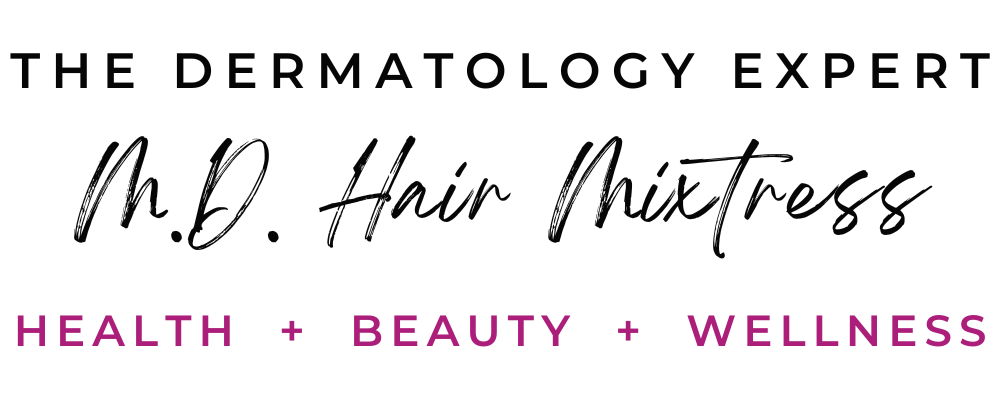Heat damaged natural hair can happen to any of us. Whether you straighten your natural hair twice a month, or twice a year, heat damage can still happen to you. Here are some tips on how to avoid heat damage, and what to do if it does happen to you.
What is Heat Damaged Natural Hair?
Heat damage occurs when the bonds that make your hair curl (disulfide bonds) are permanently broken by too much heat. Without these little disulfide bonds, your hair will be weaker and will lose it usual coils and curls. Hair with broken disulfide bonds is more likely to be weak, fragile and break. Too much heat can also damage the cuticle of your hair, make it very porous. Porous hair is very likely to lose too much moisture, and therefore be less elastic and break more easily. You can read more about high porosity hair here.
What Does Heat Damaged Natural Hair Look Like?
- Looser curl pattern
- Straight pieces of hair
- Brittle
- Frizzy
- Split ends
- Inability to hold a curl
- Dry
Preventing Heat Damage
1. Use a Good Flat Iron
If you’re going for a straight look and need to use a flat iron, make sure that it’s a good one. Always get a flat iron with a dialed temperature control so that you can control exactly how much heat is going on your hair. Ceramic flat irons are very good for natural hair, as the ceramic helps better distribute heat. Tourmaline flat irons are also good for natural hair, since they generate moisture locking ions that help reduce frizz. HSI Professional Glider Ceramic Tourmaline Ionic Flat Iron Hair Straightener has both ceramic and tourmaline and is excellent for straightening natural hair.
2. Don’t Go Over 350°F
Higher heat temperatures are more likely to cause heat damaged natural hair. Many naturals think that their hair is coarse and hard, but actually they have lots of very fine strands. Finer strands are more likely to be damaged by too much heat. So be careful.
3. Flat Iron Clean and Dry Hair.
Flat ironing dirty hair will damage your hair. Old product will build up on your hair and worsen dryness and damage. Applying heat to wet hair can lead to a condition called bubble hair, which will damage your hair shaft and make your hair break off.

Bubble Hair
4. Don’t Flat Iron More Than Once Weekly
5. Always Use a Heat Protectant
Using a heat protectant can be the difference between natural hair that reverts back beautifully, and straggly ends that no longer curl right. HSI PROFESSIONAL Argan Oil Heat Protector is paraben and sulfate free and contains antioxidant rich argan oil which helps defend against heat damaged natural hair.
Another great heat protectant is Shea Moisture Jamaican Black Castor Oil Strengthen & Grow Thermal Protectant. It contains shea butter to moisturize the hair and apple cider vinegar.
6. Consider a Roller Set
Setting our wet natural hair on large magnetic rollers can be a wonderful way of straightening your hair and getting big voluminous loose curl—without needing super high heat that can damage your natural hair.
Check out this tutorial from YouTube’s JayHairBigga:
Treating Heat Damaged Natural Hair
If heat damage happens to you, you’ll have to be patient as your hair grows out. If the heat damage really bothers you, you can also choose to trim it off. While you can’t typically revert heat damage, there are things that you can do to help improve the texture and behavior of your hair—even if you’ve got heat damage.
1. Protein Treatments
Protein treatments and protein rich conditioners can help restore some of the strength and integrity to your heat damaged natural hair. ApHogee Intensive 2 Minute Keratin Reconstructor helps treat brittle hair and a damaged cuticle.
2. Deep Condition
Doing a weekly deep condition will help restore some elasticity to heat damaged natural hair. SheaMoisture Manuka Honey & Mafura Oil Intensive Hydration Hair Conditioner contains intensely moisturizing manuka honey and baobab oil. Baobab oil is rich in nutrients and ideal for hair and skin. You can read more about baobab oil here.
3. Avoid Drying Product Ingredients
Avoid drying sulfate shampoos and beware of hair products that contain potentially harmful ingredients such as mineral oil, lanolin, silicone and petrolatum. These products dry your hair and can worsen breakage.
4. Use the Right Hair Care Products
Look for products that have nourishing natural ingredients like shea butter, castor oil, olive oil and coconut oil. Instead of a drying shampoos, cleanse your heat damaged natural hair with rhassoul clay, which will help your hair retain moisture and help define your curls. Add apple cider vinegar rinses (ACV) to help close your cuticle and improve shine.
Image Sources:
Bubble hair-Albers LN, Maley AM, MacKelfresh JB. Blowing bubbles: Dermoscopy of bubble hair. Int J Trichol 2017;9:122-3
Featured image photo: courtesy @3sisters1comb via Instagram








